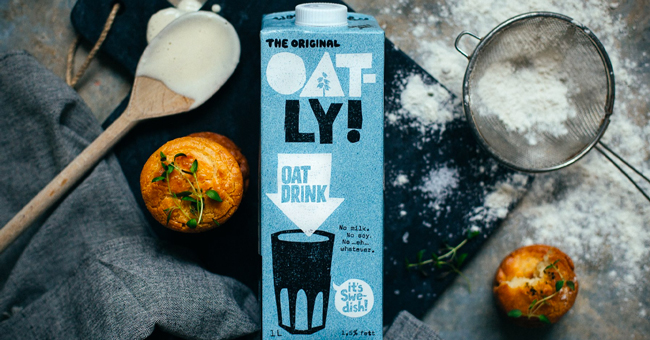Ringing in the company’s first day trading on the Nasdaq Stock Market, Oatly CEO Toni Petersson said the decision to go public was “the right thing to do.”
Initially priced at $17 per share, at the top of its predicted range — raising $1.43 billion and netting a valuation of over $10 billion — Oatly’s stock opened at roughly $21 per share, up about 24%, as it began trading shortly before noon today, and closed at $20.20 per share.
Speaking to reporters on a conference call this morning, Petersson said that although Oatly is driving a significant portion of the growth for plant-based milks in the U.S. — the company estimates it generated 13% of category growth in 2020, according to its Form F-1 filing — it still has a relatively low ACV in retail. However, he highlighted the brand’s strong presence in the on-premise channel through cafes and restaurants.
Though Petersson acknowledged that meeting demand has remained a challenge for Oatly over the past year, the company’s Utah facility is now operational and a New Jersey facility expansion, built in partnership with Innovation Foods, will go online by next year. The Utah plant, he added, will help to close the gap of the company’s fill rate and will allow the brand to expand its U.S. retail presence.
As well, the facilities will allow Oatly to grow its non-dairy ice cream alternative and Oatgurt lines, in addition to milks, as distribution for the lines had been limited due to production constraints.
“Demand … was and still is increasing continuously,” Petersson said. “And that is organic demand. It’s not pushed by any sort of price motions or pricing mechanism whatsoever…. The key driver of this is the velocity that keeps increasing all the time.”
Oatly revealed in its F-1 filing this week that sales grew 106% to $421.4 million in 2020. However, net losses increased to $60.4 million, up from $35.6 million in 2019. Petersson echoed the company’s statements in the filing that the losses are primarily due to investments in increasing capacity and expanding the organization. While he did not offer a timeline for when the company might hope to achieve profitability, he put the company’s short term goals in succinct words: “Growth over profit.”
“I think it’s super normal when you grow as much as we are doing [to report losses] and going forward on the profit side we’ve got to prioritize growth no matter what,” he said. “To be honest, we do have a very ambitious plan, but what we are focused on right now is how can we capture incremental demand.”
One strategic pillar for the brand is converting dairy consumers to Oatly, he said, noting “the addressable market is just massive.” As well, conversion is a factor in the company’s sustainability initiative: Petersson said Oatly intends to cut its carbon emissions by 50% by 2030 and that bringing in new consumers will help improve sustainability across the food and beverage industry. About 40% of Oatly’s growth, he said, comes from new consumers adopting the brand.
However, the company continues to face tough competition in the global plant-milk market. This month, Nestlé announced a new pea-based milk brand, Wunda, which will debut in the European market. Meanwhile, in the U.S., Oatly faces a fight for market share with HP Hood’s Planet Oat, Califia Farms, Chobani and other oat milk brands. Petersson said Oatly is currently outpacing its competitors in velocities and argued that the brand’s key advantage is in its authentic presentation to consumers. He said the company is not just trying to seize on a quick business opportunity and he believes that its social mission and emotional appeals will help it fend off category plays by strategic competitors.
According to IRI, Oatly sales rose 169.3% to $59.1 million in the 52-week period ending March 21. Planet Oat led the category in dollar sales, up 144.4% to $92.5 million. Meanwhile, Chobani’s oat milk line grew 958.1% to $45.9 million and Califia Farms improved 354.6% to $18.7 million.
“We’re trying to make something that is designed for human beings and better for the planet — we’re not trying to put a product on shelves just because it’s a healthy growing category and that it’s a business opportunity,” he said. “Those two things are two different mindsets in how you run the company. And I think that is something consumers can see and feel.”
